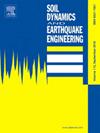Picking P-wave arrival times from microseismic signals in tunnels with low signal-to-noise ratios without noise filtering
IF 4.6
2区 工程技术
Q1 ENGINEERING, GEOLOGICAL
引用次数: 0
Abstract
Microseismic (MS) signals detected in tunnels feature low signal-to-noise ratios (SNRs) due to the complexity of the construction environment. As a result, MS events of low energy are hidden in the background noise so that separating such events from the noise using filtering is impractical. In this work, a new method is proposed to identify the arrival times of P-waves in such circumstances that does not require noise filtering. We call it the instantaneous phase difference intensity of P-waves (IPDI_P) method. The key requirement of the method (which is naturally met when monitoring MS signals in tunnels) is that the source wave travelling path difference between the target and auxiliary signals is not larger than the wavelength of the P-wave. IPDI_P functions are constructed that correspond to specific characteristics between the target and auxiliary signals. We take the first peak equal to, or close to, the maximum value of the IPDI_P curve to correspond to the P-wave arrival time of the target signal. The amplitude distributions of the two main noises in a tunnel (electrical noise and mechanical vibration) are first analyzed in the time- and frequency-domains and then accurately simulated. Then, numerical simulations and a case study are made. The results indicate that the IPDI_P method is reliable in tunnels without noise filtering and its performance is better than that of more traditional methods (STA/LTA and AIC), especially for MS signals with SNRs that are less than 30 dB (so the P-wave's SNR is less than 16–24 dB). The error in the P-wave arrival time caused by mechanical noise (vibration) is larger than that caused by electrical noise. The principles underlying auxiliary signal selection are also discussed. Our study is an important step towards the development of a fully-automatic MS-based rockburst detection system for use in deep tunnels.
无噪声滤波的低信噪比隧道微地震信号p波到达时间提取方法
由于施工环境的复杂性,隧道中检测到的微震信号具有低信噪比的特点。因此,低能量的MS事件被隐藏在背景噪声中,使用滤波将这些事件从噪声中分离出来是不切实际的。在这项工作中,提出了一种新的方法来识别在这种情况下不需要噪声滤波的p波到达时间。我们称之为纵波瞬时相位差强度法(IPDI_P)。该方法的关键要求(在隧道中监测MS信号时自然满足)是目标和辅助信号之间的源波传播路径差不大于p波的波长。IPDI_P函数是根据目标信号和辅助信号之间的特定特征构造的。我们取等于或接近IPDI_P曲线最大值的第一个峰来对应目标信号的纵波到达时间。首先分析了隧道内两种主要噪声(电噪声和机械振动)的时域和频域幅值分布,并对其进行了精确模拟。然后进行了数值模拟和实例分析。结果表明,IPDI_P方法在无噪声滤波的隧道中是可靠的,其性能优于传统方法(STA/LTA和AIC),特别是对于信噪比小于30 dB的MS信号(即p波信噪比小于16-24 dB)。由机械噪声(振动)引起的纵波到达时间误差大于由电气噪声引起的纵波到达时间误差。本文还讨论了辅助信号选择的基本原理。我们的研究是开发用于深埋隧道的全自动ms岩爆探测系统的重要一步。
本文章由计算机程序翻译,如有差异,请以英文原文为准。
求助全文
约1分钟内获得全文
求助全文
来源期刊

Soil Dynamics and Earthquake Engineering
工程技术-地球科学综合
CiteScore
7.50
自引率
15.00%
发文量
446
审稿时长
8 months
期刊介绍:
The journal aims to encourage and enhance the role of mechanics and other disciplines as they relate to earthquake engineering by providing opportunities for the publication of the work of applied mathematicians, engineers and other applied scientists involved in solving problems closely related to the field of earthquake engineering and geotechnical earthquake engineering.
Emphasis is placed on new concepts and techniques, but case histories will also be published if they enhance the presentation and understanding of new technical concepts.
 求助内容:
求助内容: 应助结果提醒方式:
应助结果提醒方式:


